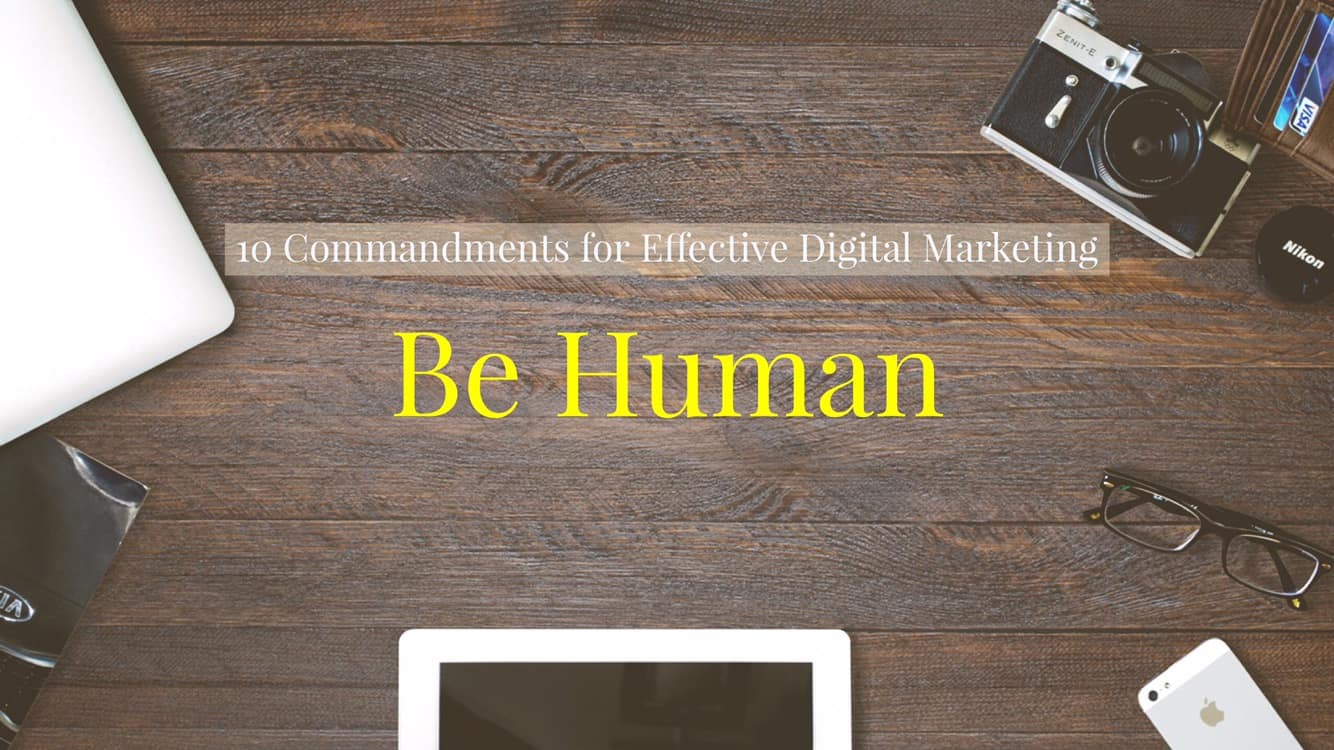The internet has transformed the way we live. It has also affected the way we conduct business. Technology enabled us to connect with each other even if we are not physically located together. As a result, this reliance on technology and the efficiencies it brings slowly changed the way businesses talk to customers. Companies that use effective digital marketing are succeeding, while the ones stuck in the traditional ways are falling behind.
Businesses lost the social aspect. Whether you are in a B2B or a B2C company, remember that you are still talking to people. Some are no longer making a distinction between a B2B or a B2C company. For them, all businesses are P2P (people to people).
Humans love to be with other humans. History proves this to be true, just read about Dunbar’s number. While technology continues to make things more efficient for us, it has not removed mankind’s need for social connections. This holds true in this digital age as well, especially for marketing, because you are the primary person in-charge of communicating to customers and would-be customers.
If you are communicating like a robot, you are alienating a lot of people from your messaging.
Why not connect with them at a personal level? Trust me, you will reap more rewards. Hint: customized, anyone?
A little aside here: I consider myself to be an introvert. Yes, while working, I prefer to do things alone but at the end of the day, I still go back to the comforts of having my family and loved ones around. I still talk to my colleagues. I talk to my friends. No man is an island, remember?
Ok. I’m convinced. So, what do I do now?
Before getting to specific actions, let me take this time to elaborate on a concept you might not be familiar with. Marketing (this means you) represents the company to the customers.
By virtue of your role, you are already the “assigned” point-person. You don’t need any further “authority” to speak in behalf of the company. In addition, as a function of you being an employee of the company, you already carry its name wherever you go, even after office hours. You are the company to the customers. Those two concepts are basic career concepts you can’t ignore if you want to be successful.
6 Quick Changes You Can Do to Represent the Company Effectively and Be Human
There are two aspects to this. First is administrative side and the next is the actual communication.
Administrative Aspect
1) Use your personal work email
This has got to be the easiest change you can do if you’re using email marketing. Stop hiding behind a [email protected] email address. If you are using a newsletter or practicing Inbound Marketing, send from YOUR work email. Just search for it on Google about how sending from your email and you’ll find tons of results about its effectivity. To prove this, I quickly searched for “using work email increase open rates” and got tons of results. Here’s a quote from coschedule.com regarding using your email address:
Our emails are by people, from people, for people. They aren’t from vague brands, apps, or objects with a possible nefarious agenda against humans. People connect with people, not with inanimate objects.
2) Include a photo of you
If I told you that including a photo of you increases the chances of your recipient replying to you by 30%, would you not place yours?
Putting a face in the mind of the recipient (lead, customer, or prospect) makes you more credible. It gives off that sense of “hey, I’m talking to another person. I might as well reply because I know this person.” Check out these 10 email marketing statistics that will convince you to grow your email list.
Here’s a standard signature block I have at my previous work:
3) Include a name when responding to social media
This is another fairly easy task to do. Call it a hack if you will.
Use your name when replying to comments on Facebook. When I was doing this, I use the convention of [Admin Ariel] at the end of the post or message, wherever the customers post.
On Twitter, sometimes I reply “as the company.” Sometimes, I reply “as myself.” Then, as what I learned from Honeycomb Communities, “leave a trail of breadcrumbs” to lead these people back to your brand.
What does leaving a trail of breadcrumbs mean? By including in your bio description who you are. If you’d look at my Twitter account, you’ll see that I am the Operations Officer of buqo (the brand). Just make sure you are consistent (signature block and title on bio description are the same).
Oh, and I hope you noticed the preparatory comment I made above? The one that says as an employee, I already represent the company wherever I go. Obviously, my Twitter account is personal, but I included that bio description there. Check my LinkedIn account and you’ll see that there as well.
Communication proper
1) Talk / write as if you are talking to a person in front of you
Stop sounding awkward. If you are writing a letter, sending out an email, or writing a press release, please do not use “greetings” or “good day” in there. Simply drop that from your writing / speaking style.
Business communication is all about being personal (tired of hearing this?). Do you do that when you talk to someone face-to-face? Imagine walking down your company’s hallway and your colleague is walking towards you as well.
Greetings John!
Weird right? So stop doing it. Use everyday language.
Here’s a hint: record yourself while reading the message out loud. Play it back. If it sounds like a robot, that’s how your customers would also feel. And last I checked, humans prefer dealing with humans. That’s why the customer service industry globally is so huge.
2) Answer questions when asked on social media. Don’t refer them to an email black hole.
Social media enabled the customers to talk to the company directly. Before, the only way customers interact with companies is through the store or the sales people. That’s not how it works anymore. What used to be a one-way communication street turned into a two-way street. Your customers (and noncustomers for that matter) follow you and/or see you on social media.
You are in-charge of the company’s social media accounts. Your customers asked you a question about your product or service. You reply to them by saying please email us at [email protected] or tell them go to our company’s product page.
Stop.
If that happens to you. How would you react?
I’m guessing you’d feel irritated. Those questions can be easily answered then and there. Use BLUF (bottom line up front). Answer the question, then provide necessary details or resources. For example, they asked you if you have a warranty. Reply “Yes, we do. Our policy is usually 1 year, and because we believe in our product’s quality, if you have any concerns with the product you purchased, we still accommodate the concern even if it’s out-of-warranty. Here’s a link to our website’s warranty page <insert link here>”
Now, won’t you love to hear that instead of “Please read our warranty page for your concerns” or “Please email us at [email protected] for your concerns.”
3) Engage with the community.
Communities have been there ever since. These are groups of people with shared interests. They have existed and will always exist. Put this into context of digital marketing, these are your brand’s fans and followers. They follow you because they “want” or “love” to be associated with you. Continuing from the previous item, social media is a way to talk to your customers and noncustomers. The more you know about them, their needs and wants, the better you can market to them.
Plot in your calendar this daily routine. Before, I allot 15 minutes (yup, only 15 minutes) each morning to go through my news feed (both Twitter and Facebook) then scan for comments or questions. I answer them and schedule the replies to be sent out within the day. (the scheduling is primarily for Twitter since too many replies in within a short span of time seems spammy)
I explain this to other people as having both a short-term and long-term strategy for social media. The long-term is your planned messages. These are articles you put out, marketing messages, insights, quotes, etc. These are already scheduled and plotted out for days. The short-term strategy is primarily for engagement. These are following your followers, thanking them, retweets, reshares, answer to comments, answer to questions, etc.
Oh, in case you’re wondering about software, I use HootSuite before. For my current work, I’m using HubSpot.
There are a lot of alternative options out there (just search for social media management software and you’ll get tons of results). I had a chance to use HootSuite, HubSpot and Buffer. Each one has their own pros and cons. You just have to find what suits you best.
The internet has changed our lives. It permeated both our personal and professional lives. However, we should not lose sight of the social or community aspect of being humans. I believe the popular word for this is called empathy.
Connect with your audience.
In turn, this will build their trust, increase your credibility, and be more receptive to you. This is the second commandment of effective digital marketing. Let me know what you think in the comments below.

